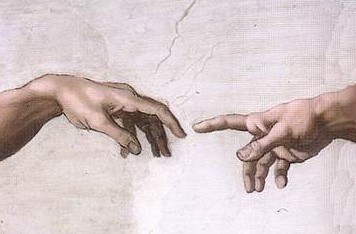
Log in, contemplate and transcend: an art lover’s guide to online viewing
Carolyn Morrison takes a look at what’s on offer on social media platforms while the world’s great museums and galleries remain closed.
Taking time to pause and reflect on some of the world’s most exquisite works of art could improve your mind and soul. Recent research has shown that the Arts help us to enhance our cognitive, creative and social abilities. This is nothing new: the Arts are renowned for being sources of joy, inspiration and edification. For Plato the Arts were means of promoting the good, the moral and the beautiful. While some religious traditions have been suspicious of the Arts, Christianity in the main has seen them as pointing beyond themselves and acting as a means of encountering divine beauty for the glory of God and the sanctification of the faithful. For proof of this, visit Italy (after the lockdown).
However, since mid-March, museums, art galleries and libraries have been closed and plan to stay closed until it is safe to reopen.
Fortunately, many of the world’s cultural institutions have a strong online presence. YouTube, Google Arts and Culture app and #MuseumsFromHome are just some of the social media platforms which offer virtual tours, online collections, and history of art videos.
Social media platforms offer an attractive mix of high-resolution imagery and visual trickery. By far the most effortlessly accessible platform from which to get your art fix is YouTube. The National Gallery’s YouTube channel has a marvellous selection of informative art history lectures to choose from.
From all that’s on offer on the internet, here are seven noteworthy attractions for you to explore…
Noteworthy attraction 1:
Dr Carlo Corsato’s fascinating 48-minute educational talk on The altarpiece in Italy in the age of Leonardo. Discover how the delights and insights from Piero della Francesca’s The Baptism of Christ inspired Leonardo da Vinci to create his mystical altar masterpiece The Virgin of the Rocks.
Dr. Carsato explains to the viewer that altarpieces are always designed with the community in mind. You can learn how they are designed to be site specific, contain a religious narrative, serve a specific function as liturgical items, and how vision and public worship all play a part in the composition of the altarpiece. This lecture draws you in and makes you feel part of the art community.
Noteworthy attraction 2:
Another noteworthy attraction that you can find on YouTube is a documentary entitled Inside the Vatican Museums. The Vaticano Special is an EWTN production which provides a spectacular, inspirational and informative glimpse of the wonders and workings of the Vatican Museums. See some of the world’s greatest works of art and the people responsible for their upkeep.
Meet Gianni Crea, the senior key keeper of the Vatican Museums, who starts work at 5.30am each morning to open up 300 doors. One of the smallest keys turns on the lights inside the Raphael Rooms. In this room, the freshly restored frescoes took over 30 years to complete. However, the Sistine Chapel ceiling (Volta della Cappella Sistina), which was painted by Raphael’s arch-rival Michelangelo, is undoubtedly the pearl of the Vatican and the star of the show.


The central panel of the Sistine Chapel ceiling is a composition of nine biblical scenes which are based upon the Bible’s Book of Genesis. Of the nine scenes Michelangelo’s depiction of The Creation of Adam is considered to be the masterpiece. The near touching of hands represents the moment when God imparts the spark of life into Adam. Adam’s outstretched arm mirrors that of God, illustrating that humanity is made in the image of God.
But although this depiction of the creation of Adam is one of the most iconic images of all time, it is not theologically correct. According to Scripture God “breathed the breath of life into Adam’s nostrils and he began to live” (Genesis 2:7), which is a far more remarkable encounter with the Divine than the near touching of hands. This is because the breath that God imparts to Adam is the gift of life itself, namely, the Holy Spirit. Nevertheless, the iconic image is inspiring all the same as it is archetypal of humanity’s original longing to touch and be touched by the Divine.
Noteworthy attraction 3:
Another social media platform, the Google Arts & Culture app, enables the viewer to visit some 2,000 cultural institutions in over 80 countries around the world. Hit the explore tab on the homepage and transport exquisite works of art into the comfort of your own home; from Filippo Lippi’s Madonna and Child at the Uffizi Gallery to the Mona Lisa at The Louvre, to An Indian Summer Day on Claverack Creek at the Metropolitan, New York City.
Follow the History of Art timeline in Western and Eastern art movements, from Prehistoric art to the Renaissance and right up to contemporary arts. Set aside some time to explore the impact and influence they had and continue to have on the religious, political and social cultures from which they emerged. With our lives on what seems like pause, it is a great opportunity to relax and contemplate the transcendental qualities of the aesthetic.
Noteworthy attraction 4:
From the Google Arts & Culture app, but worth singling out, the fall of the Rebel Angels is a 360o virtual reality video lasting three minutes and 46 seconds. Painted in 1562 by Pieter Bruegel the Elder, it depicts the Archangel St Michael casting the devil and his cohort out of heaven. A spectacular collage of high-resolution imagery reveals in magnificent detail St Michael portrayed in glimmering golden armour conquering Lucifer amid a grotesque cohort of fallen angels, half-human, half-animal monsters.

The theme of the painting is taken from the Bible’s Book of Revelation (12:2-9) which is a prophecy of warning and hope. It portrays an epic battle between good and evil, virtue and vice. The conflict was caused by the cardinal sin of pride which Christians believe is the most serious of the seven deadly sins.
This short video attempts to incorporate and summarise the entire history of the celestial battle for the salvation of humankind. Quite a feat!
In addition to 360o videos the Google Arts & Culture app provides online exhibitions, collections and great art up close.
Noteworthy Attraction 5:
Counter Point: Composition VI – Composition VII by Vasily Kandinsky is an online exhibition on show at The State Tretyakov Gallery, Moscow. This exhibition provides excerpts of commentary by the artist on Composition VI & Composition VII which are set against Schoenberg’s Quartet No. 2 – 4th movement. Kandinsky was interested in painting lines, shapes and colours freed from recognisable objects to evoke a visual ‘language’ of music. For Kandinsky this is “music in visual form”.

Noteworthy Attraction 6:
The third and final social media platform that I recommend is #MuseumsFromHome. This resource from the Mid-Atlantic Association of Museums is an art forum for the learned and those who are interested in becoming seriously informed. It aims to educate in an array of field-specific study programmes.
Noteworthy Attraction 7:
MetPublications – with 1,500 online art history publications, bulletins and journals to choose from, free of charge, is well worth taking the time to explore. Choose from The Art of Illumination: The Limbourg Brothers and the Belles Heures of Jean de France, Duc de Berry by Timothy B. Husband or maybe you will be more drawn to Dangerous Beauty: Medusa in Classical Art in The Metropolitan Museum of Art Bulletin by Karoglou Kiki or perhaps Art of the Islamic World: A Resource for Educators edited by Ekhtiar, Maryam D. and Claire Moore.
Although viewing art online will never compare to seeing the real thing, social media platforms offer a good substitute in times of need. Log in, contemplate and transcend!
Alternatively, why not take the advice coming from the Royal Academy of Art as they launch a new online series of artists and architects documenting their creativity in isolation? As artist in isolation Rebecca Salter PRA says:
“Who knows how many new talents will pick up a pencil, brush or iPad in isolation?”
Like what you’ve read? Consider supporting the work of Adamah by making a donation and help us keep exploring life’s big (and not so big) issues!

7 Comments
Chris Doran
Sr Catherine, this is wonderfully helpful. Thank you!
Have you come across Fr Marcus Hilden’s ‘Divinitas’ series? Here’s the first one: https://vimeo.com/399858264
Thanks again.
Chris Doran
Sorry – Sr Carolyn!
Chris Doran
Sr Carolyn, this is wonderfully helpful. Thank you!
Have you come across Fr Marcus Hilden’s ‘Divinitas’ series? Here’s the first one: https://vimeo.com/399858264
Thanks again.
بقايا
that was informative peace of art ur article
موقع بقايا
thank u
b8aya.com
alot of info thank u alot
ปั้มไลค์
Like!! Great article post.Really thank you! Really Cool.